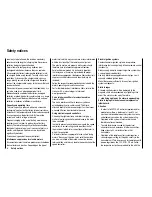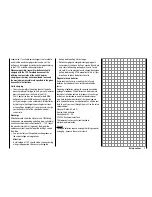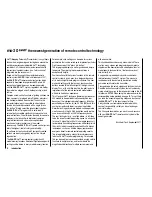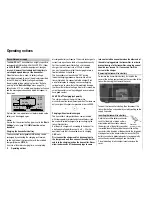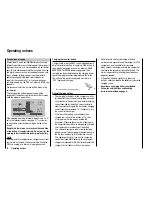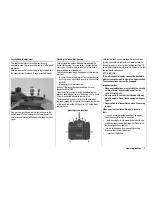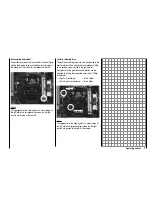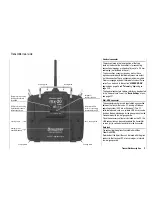
8
Safety notices
Safety notices and handling instructions for nickel-metal-hydride rechargeable batteries
As applicable for all highly technical products,
observance of the following safety notices, along with
the handling instructions, is essential for a long service
life, fault-free operation, and harmless utilization.
Safety notices
Individual battery cells and batteries are not toys and
•
must therefore not get into the hands of children.
Batteries/cells must be kept out of the reach of
children.
Batteries are to be checked for fl awless condition
•
prior to every use. Defective or damaged cells/
batteries may no longer be used.
Cells/batteries may only be utilized within the limits
•
specifi ed by the technical data for the given battery
type.
Batteries/cells may not be heated, burned, short-
•
circuited or subjected to overload current or
reverse polarity.
Battery confi gurations formed by parallel
•
connected cells, combinations of old and new
cells, or cells of different production, size,
capacity, manufacturer, brand or cell type may
not be used.
Remove batteries from the unit prior to long-term
•
storage periods (weeks or months). Always switch
off units whenever they are no longer in use (short-
term). Always charge batteries before it is too late.
The battery to be charged must be placed on a non-
•
combustible, heat resistant, non-conducting surface
during the charging process. Combustible or readily
ignited objects are to be kept away from the charging
confi guration.
Batteries may only be charged under supervision.
•
The quick charge current rating for the given type of
battery must never be exceeded.
If the battery heats up during charging above 60 °C
•
charging must be stopped immediately. Allow the
battery to cool off to about 30 °C before resuming the
charging process.
Never charge batteries which are already charged,
•
batteries which are hot or batteries which have not
been discharged to their end-point voltage.
No modifi cations may be made to the batteries.
•
Never solder or weld directly on battery terminals.
The mistreatment of batteries presents a danger of
•
ignition, explosion, chemical burns and combustion
burns. Use of an extinguishing blanket, CO
2
-fi re
extinguisher or sand are suitable methods of
extinguishing such a fi re.
Leaking electrolyte is caustic; do not allow it
•
to contact the skin or eyes. In the event of an
emergency, immediately rinse with a generous
amount of water and get the care of a doctor.
Battery vent openings may never be blocked or
•
sealed, e. g. by solder. Soldering temperature may
not exceed 220 °C and not be applied for longer than
20 seconds.
To avoid deformation, do not exert excessive
•
mechanical force.
If a battery should become overcharged, proceed as
•
follows:
Simply disconnect the battery and place it on a non-
combustible surface (e. g. masonry fl oor) until it has
cooled off. To avoid the hazards associated with an
explosion, never hold the battery in your hands.
Pay attention that the charging and discharging rules
•
are followed.
General notices
Battery capacity is reduced by every charge/discharge
cycle. Storage can also be cause for a gradual reduction
of battery capacity.
Storage
Batteries should only be stored when they are not in a
completely discharged condition. They should be stored
in a dry room having an ambient temperature between
+5 °C to +25 °C. When stored for longer than 4 weeks,
cell voltage should
not be more
than 1.2 V.
Matching up individual batteries
To match new batteries with older ones, put a full
•
charge on all of the batteries using a standard
charging process. As a rule of thumb, an
empty
battery must be charged for 12 hours at a current
rate equal to one tenth of its specifi ed capacity
("1/10 C" method). The batteries are then all charged
equally. Such a matching procedure should be
repeated about every 10th charge cycle so that
batteries are matched again, which contributes to
longer battery life.
If it is possible to discharge individual batteries, this
•
should be done prior to every charging process.
Otherwise the battery pack should be discharged
to a voltage of 0.9 V per cell. For example, this
corresponds to a charge voltage of 3.6 V for the
4-cell pack used in the transmitter.
Charging
Charging is only permissible at specifi ed current rates,
charging durations, temperature ranges and continuous
Summary of Contents for mx-20 Hott
Page 41: ...41 Your notes...
Page 49: ...49 Your notes...
Page 55: ...55 Your notes...
Page 81: ...81 Your notes...
Page 85: ...85 Your notes...
Page 89: ...89 Your notes...
Page 99: ...99 Detail program description Control adjust...
Page 127: ...127 Detail program description Control adjust...
Page 131: ...131 Detail program description Control adjust...
Page 163: ...163 Detail program description Control adjust...
Page 191: ...191 Detail program description Control adjust...
Page 207: ...207 Detail program description Control adjust...
Page 228: ...228 Detail program description Control adjust...
Page 229: ...229 Detail program description Control adjust...
Page 251: ...251 Detail program description Control adjust...






